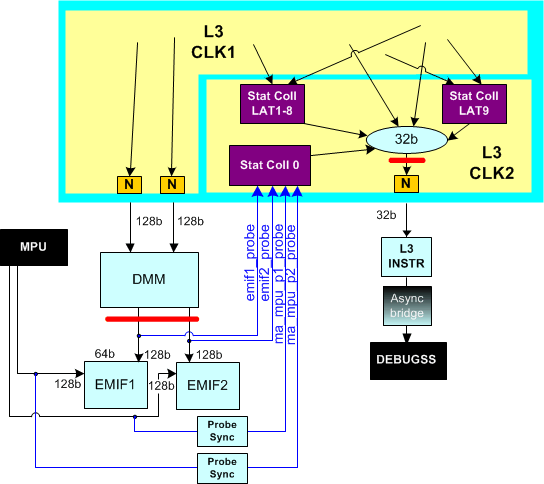SPRAC21A June 2016 – June 2019 OMAP-L132 , OMAP-L138 , TDA2E , TDA2EG-17 , TDA2HF , TDA2HG , TDA2HV , TDA2LF , TDA2P-ABZ , TDA2P-ACD , TDA2SA , TDA2SG , TDA2SX , TDA3LA , TDA3LX , TDA3MA , TDA3MD , TDA3MV
-
TDA2xx and TDA2ex Performance
- Trademarks
- 1 SoC Overview
- 2 Cortex-A15
- 3 System Enhanced Direct Memory Access (System EDMA)
- 4 DSP Subsystem EDMA
- 5 Embedded Vision Engine (EVE) Subsystem EDMA
- 6 DSP CPU
- 7 Cortex-M4 (IPU)
- 8 USB IP
- 9 PCIe IP
- 10 IVA-HD IP
- 11 MMC IP
- 12 SATA IP
- 13 GMAC IP
- 14 GPMC IP
- 15 QSPI IP
- 16 Standard Benchmarks
- 17
Error Checking and Correction (ECC)
- 17.1 OCMC ECC Programming
- 17.2 EMIF ECC Programming
- 17.3 EMIF ECC Programming to Starterware Code Mapping
- 17.4 Careabouts of Using EMIF ECC
- 17.5 Impact of ECC on Performance
- 18 DDR3 Interleaved vs Non-Interleaved
- 19 DDR3 vs DDR2 Performance
- 20 Boot Time Profile
- 21 L3 Statistics Collector Programming Model
- 22 Reference
- Revision History
18.3 Impact of Interleaved vs Non-Interleaved DDR3 for Multiple Initiators
To understand the total available DDR bandwidth of the system for the interleaved versus non-interleaved mode of operation, it is required to have a multi-initiator test. In this synthetic test, the following initiators are used for the interleaved versus non-interleaved case. The DSS reporting an Underflow error was used as a reference point to know when the DDR bandwidth is maximized out in the system.
NOTE
In the current experiment for the non-interleaved case, the data is not routed through EMIF2 and the system is assumed to be a single, 32-bit DDR system.
Non-Interleaved initiators:
- IVAHD: Executing 1080p60 decode
- BB2D: Executing 1280x720 NV12 3 frame overlay
- DSP1 EDMA single TC
- DSS 3 VID + 1 GFX pipe: 2 VID pipes 720p ARGB8888, 1VID + 1 GFX RGB888
Interleaved initiators:
- IVAHD: Executing 1080p60 decode
- BB2D: Executing 1280x720 NV12 3 frame overlay
- DSP1 EDMA single TC
- DSS 3 VID + 1 GFX pipe: 2 VID pipes 720p ARGB8888, 1VID + 1 GFX RGB888
- DSP2 EDMA two TC
- System EDMA two TC
The throughput is measured using statistic collectors available in the L3 at the EMIF1_probe and EMIF2_probe as shown in Figure 54. The statistic collector registers are read every 100 µs for 5 seconds and the bandwidth data is obtained by dividing the number of bytes transferred in 100 µs divided by 100 µs.
 Figure 54. L3 STATCOLL EMIF1 and EMIF2 PROBE Mechanism
Figure 54. L3 STATCOLL EMIF1 and EMIF2 PROBE Mechanism The ideal throughput for DDR3 running at 532 MHz is:
- For the non-Interleaved case, 532 MHz × 4 bytes × 2 = 4256 MB/s
- For the interleaved case, (Non-Interleaved value × 2) = 8512 MB/s
Table 91 shows that when the EMIF FIFOs are fully occupied then the system can expect a 10-15% boost in performance by configuring the EMIFs in interleaved mode versus a non-interleaved mode.
Also note that this is a synthetic test to measure the maximized out EMIF throughput. When executing a real system use-case, you can expect around 55-60% DDR utilization.
Table 91. Impact of Interleaved vs Non-Interleaved DDR3 for Multiple Initiators
| Non-Interleaved (One 32-Bit Memory) | Interleaved (Two 32-Bit Memory) | |||||
|---|---|---|---|---|---|---|
| EMIF1 Bandwidth | EMIF2 Bandwidth (No Traffic to EMIF2) | Total | EMIF1 Bandwidth | EMIF2 Bandwidth | Total | |
| Maximum Bandwidth (MB/s) | 3121.60 | NA | 3121.60 | 3650.88 | 3642.88 | 7293.76 |
| Average Bandwidth (MB/s) | 2458.25 | NA | 2458.25 | 3035.51 | 3045.00 | 6080.51 |
| Maximum DDR Utilization | 73% | NA | 73% | 86% | 86% | 86% |
| Average DDR Utilization | 58% | NA | 58% | 71% | 72% | 71% |